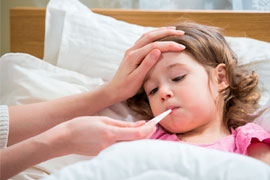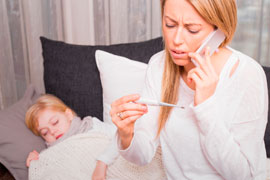April 27th, 2017
Getting Worked Up Over Kids’ Fevers
Emily F. Moore, RN, MSN, CPNP-PC, CCRN

Emily F. Moore, RN, MSN, CPNP-PC, CCRN practices pediatric cardiovascular care across the Pacific Northwest.
Few things worry a mother more than a baby with a fever. With my own girls, I am naturally uneasy and do not like when they have fevers, even though as a health care provider I know that fevers are natural. But it wasn’t until my three-year-old started having chronic fevers that I realized how unsettling it could be.
Her fevers first started shortly after she turned 6 months and coincidentally started daycare. I thought it was a sign that her body was building her immune system. Her fevers ranged anywhere from 101 to 105 degrees and occurred randomly every few weeks to months. Sometimes she was miserable, at other times she was fine and played right through them. Through it all she thrived. I was never once worried about her development.
 After her subsequent diagnoses of chronic ear infections, pertussis, pneumonia, periorbital cellulitis, reactive airway disease, and influenza, we were referred to immunology for an extensive workup. I remember sitting there thinking, as a provider, that she was fine. She had followed a normal growth curve, was meeting developmental milestones, and was ahead of the curve academically. But as a mother, I couldn’t help but worry — what would I do if anything came back positive? Our provider’s initial clinical impression was that my daughter likely had cyclic fever disorder and there would be nothing we could do. In order to make this diagnosis, we had to rule out T and B cell dysfunction. So we were sent to have lab work done.
After her subsequent diagnoses of chronic ear infections, pertussis, pneumonia, periorbital cellulitis, reactive airway disease, and influenza, we were referred to immunology for an extensive workup. I remember sitting there thinking, as a provider, that she was fine. She had followed a normal growth curve, was meeting developmental milestones, and was ahead of the curve academically. But as a mother, I couldn’t help but worry — what would I do if anything came back positive? Our provider’s initial clinical impression was that my daughter likely had cyclic fever disorder and there would be nothing we could do. In order to make this diagnosis, we had to rule out T and B cell dysfunction. So we were sent to have lab work done.
Had I known the extent of the lab work needed, I may have asked more questions to prepare myself and my daughter on what to expect. Instead, I ended up holding my daughter while she screamed, “They are bleeding me, Mama!” Everything came back normal, and we settled with the diagnosis of fever syndrome. Our provider wanted to send us to rheumatology and run more labs, and she also discussed the possibility of a tonsillectomy. At that point, I elected not to work her up any further and only treat symptoms as they presented. I knew there was not much more we could do, and the thought of continued testing sounded traumatizing, for both of us.
 Fevers are one of the most common clinical symptoms managed by pediatricians and health care providers in general. Parents are often concerned with the need to maintain a normal temperature. Yet, the use of antipyretics is not always beneficial. We should be teaching our parents to treat symptoms, not numbers. When providing counseling, we should emphasize the child’s comfort and signs of serious illness rather than normothermia. Of course, we should teach parents that it’s important to seek care when fever persists after 3 days in infants and children, for any fever in a baby who is 3 months old or less, or if fever is over 104 degrees. But we also need them to trust their instincts. If a child looks unwell in the face of fever and doesn’t seem to be improving as one would expect, it is okay to call the pediatrician for help.
Fevers are one of the most common clinical symptoms managed by pediatricians and health care providers in general. Parents are often concerned with the need to maintain a normal temperature. Yet, the use of antipyretics is not always beneficial. We should be teaching our parents to treat symptoms, not numbers. When providing counseling, we should emphasize the child’s comfort and signs of serious illness rather than normothermia. Of course, we should teach parents that it’s important to seek care when fever persists after 3 days in infants and children, for any fever in a baby who is 3 months old or less, or if fever is over 104 degrees. But we also need them to trust their instincts. If a child looks unwell in the face of fever and doesn’t seem to be improving as one would expect, it is okay to call the pediatrician for help.
In regard to my daughter, she continues to blossom despite these recurrent fevers and infections. I have learned to take her fevers as one of many symptoms that develop when responding to infection. I certainly use medications like Tylenol when she is especially feverish, refusing to eat, punked out, and exhausted. This works, and she often quickly bounces back, regaining energy and improving her fluid intake and appetite. But I certainly don’t treat every fever, and I don’t recommend to my patients’ parents that they run for the medicine cabinet whenever they feel a warm forehead.



Classic case of OOTT (One Of Those Things) – like growing pains, headaches, rashes and swellings that never become defined.
People in the medical field struggle between OVER medicalizing (medical hypochondriasis) and UNDER responding (denial, normalization or minimization) – perspective is challenging in these circumstances.
Max,
I couldn’t agree more. With my daughters first illness, I waited a little too long before taking her in. One of the first things our PCP educated me about was the differences between a cardiac baby (the population I treat) and a normal healthy baby. Apparently, my daughter was not supposed to look like she was in heart failure! I have been more reactive since. Actually, probably a little hyper-vigilant immediately after. Now with two girls, both in daycare, I am somewhere in the middle, treating symptoms over numbers. Not an easy skill to learn or teach!
Thank you for your comment,
Emily
Hi Emily,
Another good article- but this one with no simple explanations.
Another humbling experience for all of us.